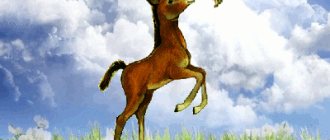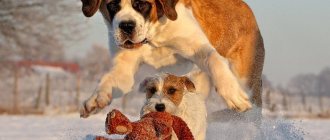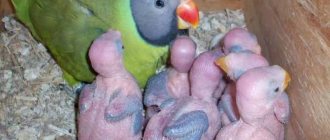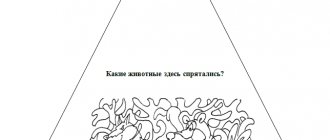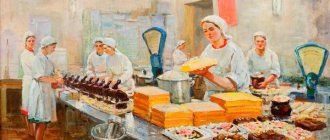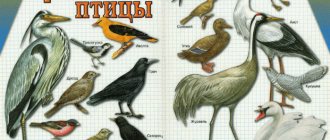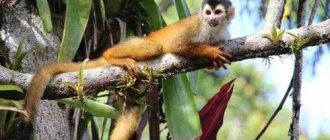Thematic lesson on speech development “Pets”
- How to tell your child about pets?
- How can I help him remember the “names” of mothers and babies of the animal world?
- How to use this lexical topic to organize a lesson on speech development for a preschooler?
Eureka knows!
We will teach you, friends, how to competently combine exciting games, study of lexical topics, automation of difficult-to-pronounce sounds, and exercises to develop the grammatical structure of the language in one lesson.
Lesson based on the picture “In the village”
Print out this or a similar picture, place it in front of your child and talk to him about the content. The conversation plan should be appropriate to the child’s age.
Ask the little ones to point with their fingers at the animals they have seen before in a picture, in cartoons or in real life (at home, on the street, at grandma’s in the village, at the zoo). Let the child, to the best of his acting talents, demonstrate how pigs, cows and other pets shown in the picture communicate with each other. When the little one shows everyone he recognizes, name the rest of the animals and birds, tell him what benefits they bring to humans, what their babies are called, where they live and how they “talk.”
With children of middle preschool age (4–5 years old) and older, a conversation based on the picture “In the Village” can be based on the following questions:
- Where do the events depicted take place?
In the village, on the farm, in the barnyard.
- What animals are shown in the picture?
If the child immediately uses a generalizing word, ask him to list the animals separately. If your child starts with a list, help him remember the general name. Make sure your child does not confuse animals and birds.
- What birds are shown in the picture?
The flow of the conversation is similar to the analysis of the previous question.
- Who is depicted in the picture as a whole family?
Chicken, duck, goat, sheep, horse, cow, pig.
- Show me and name all the babies in this picture.
The baby should point with his finger and comment: “Foal, piglet, lamb...” If the baby cannot remember the right word, be sure to tell him. Make sure that all “babies” are named correctly (no “little horses” or “little cows”).
- What are [pigs doing | cow with calf | horse with foal | chickens | ducklings | dog]?
Encourage your child to give complete answers. Ask him to explain why he thinks this way. You can make up whole stories about, for example, how a pig and a pig spent a long time cleaning their heels / and were so tired that they fell asleep right in the middle of a puddle. They sleep and smile in their sleep because they see a trough full of their favorite acorns.
- How many [cockerels] are there in the picture | chickens | chickens]?
If your child finds it difficult to answer this question, discuss with him how they differ. Make sure your baby doesn't confuse chicks and ducklings. Make sure he doesn't forget to count the chicken that has run far away from its family. Repeat why it is dangerous for young children to leave their parents or teacher alone.
- Who is eating in the picture?
The chickens eat grains and worms, and the goat and kid chew cabbage. Remember what you can treat the other animals shown in the picture with.
- Who's in the picture [running | sleeps | frolicking]?
Remember the words for different actions. For children of older preschool age, ask them to select signs for actions: “Runs fast,” “Sleeps sweetly,” “Frolics enthusiastically.”
- Now all the birds and animals are spending time together in a common yard, but where is their home?
A dog and a cat can live in a house with people, but a guard dog has his own house - a booth or kennel. Birds live in an aviary. Goats, sheep and cows in the barn. Horses in the stable. Come on, who have we forgotten? Did you pay close attention to the picture?
Speech therapy poems and sayings
Pure tongues help automate sounds that are difficult for a child. They form clear diction and develop phonemic awareness. Probably, the baby will like these little funny poems so much that he will want to compose his own works in their likeness. Well, we think you will be only too glad to discover your baby’s poetic talent.
Say each line several times. These are not tongue twisters: our task is not to speak FAST, but CLEARLY. Change your intonation and volume. In a word, enjoy the process. But, of course, do not forget to make sure that your child diligently repeats the phrases after you, correctly pronouncing all the sounds of each line.
ZA-ZA-ZA-ZA-ZA, there is a goat in the yard, ZY-ZY-ZY ZY-ZY-ZY, the goat has cabbage, ZU-ZU-ZU ZU-ZU-ZU, feed the goat quickly. OVA-OVA OVA-OVA, there is a cow next to her, GA-GA-GA GA-GA-GA, the cow has horns, MU-MU-MU MU-MU-MU, the cow says: “Moooooo.” ECHKI-ECHKI ECHKI-ECHKI, there are beautiful sheep, ETS-ETS-ETS ETS-ETS-ETS, you need wool - shear the sheep, TSA-TSA-TA TSA-TSA-CA, the lamb's mother is a sheep.
Funny speech therapy poems for children selected on the topic “Pets” are excellent material for training diction and developing memory. Read several poems with your child, and let the child learn one of them by heart.
"Piggy Pig"
Piggy Pig Oinks in his sleep: Oink and oink! Oink yes grunt! “Give me the apricot!” Piglet Piggy, Before you eat, take some soap and wash your snout!
"Chicks in kindergarten"
Ten little chickens wandered into our kindergarten. They were brought in from the street by the Mottled Chicken. Dear little hen, You are on the wrong street: This is a kindergarten, But not for chickens!
"Collie for Paulie"
Uncle Kolya gave his daughter Polya a collie puppy, but the collie puppy ran away from Polya into the field.
Games on the theme "Pets"
"We listen carefully"
Prepare an audio recording with the voices of pets and see if the child can identify whose voice is heard: cats, dogs, horses, cows, etc.
"Connect"
For this game you will need paired cards from the lexical subtopics “Moms and Babies”, “Who is what” and “Who lives where”. You can use pictures in which the desired images are divided into two columns.
In the first case, you place a picture in front of the child, and he should put a couple next to it - a baby for his mother, a house or animal food.
In the second case, you need to connect the corresponding images with a pencil. You can complicate the task a little by suggesting that the cow family be connected in red, the pig family in pink, etc.
"Who ran away"
A game to develop attention and visual memory.
Place 4 cards with pictures of pets in front of the child. Let him look at them carefully, and then close his eyes or turn away. Remove one card and ask your child to look at the table again. Who "ran away"?
- You don’t have to remove one card, but change their sequence.
- You can replace one or more cards with others.
Choose game options according to your child's age and abilities.
Ask him to voice and explain his choice.
"Good owner"
Birds and animals lived with a good man. The kind owner loved them very much and therefore always called them very affectionately:
- Not a cow - but a little cow (cow).
- Not a chicken, but a hen.
- Not a rooster, but...
- Not a dog - but...
- Not a sheep - but...
- etc.
“Describe in one word”
So many birds and animals live with humans. They help him at home and at work. They make him happy and amused. Come on, my friend, let’s find a definition for each of them:
- The rooster is brave.
- The chicken is small.
- The dog is faithful.
- The cat is cunning
etc.
Friends! The lexical topic “Pets” is extensive and opens up broad prospects for versatile teaching activities. We will definitely return to it again and again. In order not to miss the latest publications, subscribe to our news and follow us on social networks.
May your parenting be happy. See you again!
